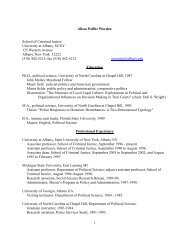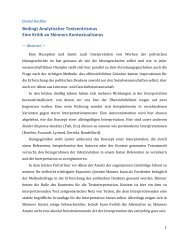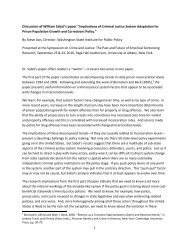Dr. Barbara Braden Additional questions from Q & A 1. Do you have ...
Dr. Barbara Braden Additional questions from Q & A 1. Do you have ...
Dr. Barbara Braden Additional questions from Q & A 1. Do you have ...
Create successful ePaper yourself
Turn your PDF publications into a flip-book with our unique Google optimized e-Paper software.
<strong>Dr</strong>. <strong>Barbara</strong> <strong>Braden</strong><br />
<strong>Additional</strong> <strong>questions</strong> <strong>from</strong> Q & A<br />
<strong>1.</strong> <strong>Do</strong> <strong>you</strong> <strong>have</strong> any suggestions for monitoring compliance with<br />
Turning/Positioning?<br />
a. There are mattress covers that monitor this and alarm when pressure<br />
on bony prominences gets too high.<br />
b. There are thigh monitors as used by <strong>Barbara</strong> Bates‐Jensen in her<br />
research study on the actual turning compliance as compared to<br />
charting.<br />
c. Lower tech? I know a DON who used to put a Post‐it note on a<br />
patient’s back that gave the time she put it there and said “call me<br />
when <strong>you</strong> turn the patient and find this note.”<br />
d. For those units where they do hourly rounds, the use of a turning<br />
clock (generally used to remind staff to turn patients) should also be<br />
used by the rounding nurse to monitor staff compliance with turning<br />
e. Various institutions <strong>have</strong> ways of communicating with their staff. If<br />
these systems can be used to notify caregivers that it is time to turn<br />
the patient that is helpful and can be used as part of the monitoring.<br />
f. <strong>Do</strong>n’t forget that <strong>you</strong> must <strong>have</strong> adequate staffing to carry out<br />
turning schedules and turning schedules that take into consideration<br />
meals and morning care<br />
(see http://www.bradenscale.com/images/turning_schedules.pdf)<br />
2. Can <strong>you</strong> speak about The <strong>Braden</strong> Plus and the <strong>Braden</strong> Q scales?<br />
a. I’ve never heard of the <strong>Braden</strong> Plus and can’t find an article on it in<br />
Medline or CINAHL. I’ve told nurses that they can add a few check<br />
points at the bottom of the <strong>Braden</strong> Scale to remind nurses of some<br />
additional risk factors common to their population, so long as they<br />
don’t change the Scale or scoring itself. It may be this sort of thing<br />
that an institution refers to as <strong>Braden</strong> Plus.<br />
b. The <strong>Braden</strong> Q (see link below) has been validated for Pedi ICU, but it<br />
probably is most predictive in older pediatric patients. It was
developed by Martha Curley and Sharon Quigley. They added a<br />
tissue perfusion subscale to the <strong>Braden</strong> Scale. It is not likely to be<br />
predictive in neonatal ICU’s and in very <strong>you</strong>ng patients.<br />
c. http://www.health.qld.gov.au/psq/pip/docs/braden.pdf<br />
3. Would <strong>you</strong> consider a past or current pressure ulcer as part of the score on the<br />
<strong>Braden</strong> Scale?<br />
a. I would consider it a risk factor, but not part of the scoring. It is part of an<br />
assessment done in determining care needs. It is important that scoring<br />
remain the same because inter‐institutional comparisons will be important to<br />
<strong>you</strong> and it will be important that state surveyors, CMA, JACHO, etc. understand<br />
the scores.<br />
4. With all the various pressure ulcer reduction items such as mattresses, cushions,<br />
etc., do <strong>you</strong> <strong>have</strong> any recommendations on how to determine what are good<br />
products and any suggested ways to determine this information?<br />
I’m afraid the best that I can do is to say that thick (at least 6 inches), high<br />
specification foam is important if <strong>you</strong> are using a foam surface. If <strong>you</strong> are<br />
using a reactive air mattress, it is important that it is inflated sufficiently<br />
that patients do not bottom out. If <strong>you</strong> <strong>have</strong> issues with microclimate<br />
(excessive perspiration, heat trapping), low air loss beds or other types with<br />
air movement. A good alternating pressure mattress has been proven both<br />
clinically effective and cost effective, particularly for patients who are at<br />
lower levels of mobility. Bigger, thicker, more active surfaces are necessary<br />
for bariatric patients.<br />
5. Why is it important to conduct the <strong>Braden</strong> Scale as directed versus modifying it?<br />
a. Because it has been validated……a process that took Nancy Bergstrom and<br />
me I0 years and more than 2 million dollars. To modify it would change the<br />
validity and would require retesting.<br />
b. As explained above, <strong>you</strong> need to use it as originally written so that <strong>you</strong> can<br />
do inter and intra‐institutional comparisons and so that external evaluators<br />
do not misinterpret what <strong>you</strong> are doing.
c. It remains OK to add a check list if a few items to the bottom of the scale, if<br />
<strong>you</strong> want the remind nurses of additional risk factors……but remember, it is<br />
important that this remain a useful clinical tool. Many nurses find the<br />
<strong>Braden</strong> Scale itself somewhat burdensome….and every item <strong>you</strong> add, adds<br />
to the burden.<br />
6. Should the <strong>Braden</strong> Scale results be sent on transfer to different settings and if so do<br />
<strong>you</strong> <strong>have</strong> recommendations for the best way to do so?<br />
8/16/12<br />
a. Yes, it is an important thing to communicate to the next setting. If the<br />
patient is going to need special support surfaces or equipment, it is best<br />
to call ahead to that can be in place before the patient arrives. I’m not<br />
sure what is meant by the best way to send it. You could send a <strong>Braden</strong><br />
Scale sheet (http://www.bradenscale.com/images/bradenscale.pdf) or<br />
at minimum, the score for each subscale, plus the total<br />
score. Otherwise, each facility has different transfer sheets and<br />
procedures, so I’m not sure how to answer.
















